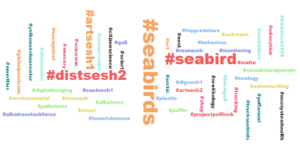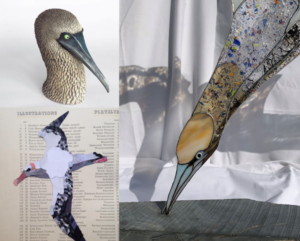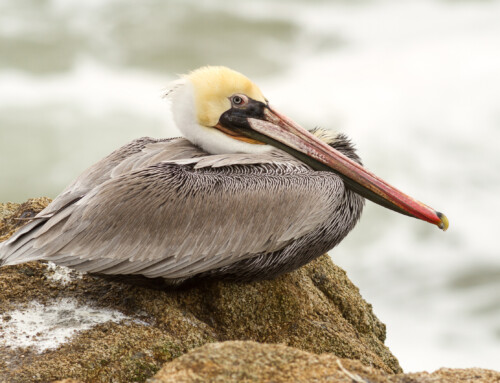“#WSTC6 was a great experience, it felt like an amazing global conference yet attended from the comfort of my sofa”. With that said, we present to you our summary and reflections of one of the biggest and best (not that we are biased) conferences of the year.
Established in 2015, the World Seabird Twitter Conference was one of the first virtual meetings of its kind and has been a continued source of inspiration for such events since. This annual event has grown bigger and better every year, and 2020 was no exception. From the 4th to 6th May, over 180 presenters shared their research in the 6th World Seabird Twitter Conference – the most presenters the conference has ever had. In just three days, the conference hashtag, #WSTC6, was used over 9000 times by over 1800 contributors and potentially reached more than 3.8 million users. This was more than double the number of tweets, contributors and reach of the previous conference, #WSTC5! Many of the hashtags used trended on Twitter and Twitter feeds were filled with splendid seabird-related conversation.

Figure 1 No surprise at the most used hashtag of the conference…. Image produced using the hashtag tracking tool on www.trackmyhashtag.com
One of the major benefits of organising such a successful online event, was the ability to connect with researchers all over the globe from the comfort of home. In a year when our ability to attend conferences in person has been temporarily lost, virtual meetings like this are a great way to allow us to continue communicating our research in a conference-style setting. It’s low cost, low carbon ethos meant no one should have felt excluded from attending on financial or environmental grounds. In the words of one participant, it was “truly open access science”. Similarly, the conference promoted a friendly and welcoming atmosphere, encouraging presenters from all career stages to participate. As Early Career Researchers, we know that global conferences can sometimes feel intimidating, and the dreaded imposter syndrome can all too easily creep up. However, the session chairs were a wonderful, friendly bunch, who did an excellent job answering questions, diffusing worries, and providing rapid support for those that experienced technical glitches on the day.
The range of talks at #WSTC6 was huge with 16 different session themes, many of which were split into multiple sessions. Three of these were led by our excellent plenary speakers, Tom Hart (@penguin_watch) Jennifer Provencher (@jenni_pro), and Mercedes Santos (@mechasantos). Together, they generated a lot of attention over the course of the conference, which led to theirs being the most ‘attended’ academic sessions.

Figure 2 The conference saw 16 session themes presented across 26 sessions. Image produced by Kirsty Franklin
This year also saw the introduction of dedicated sessions to the programme to which presenters were invited, as well as being open to general submission. Three of these dedicated sessions were chosen to reflect timely areas of seabird research: the impacts of light pollution on seabirds, using digital imaging to collect data, and changes to seabird phenology resulting from climate change. All three received a high number of abstracts, with digital imaging having to be split over three days to accommodate all presenters.
By far the most retweeted/ liked/ mentioned of all of the thematic sessions (and indeed of all sessions) were those showcasing seabird art. These presentations exhibited a variety of beautiful seabird art pieces, and stories of how this art was being used to communicate both the incredible lives of these birds and the threats facing them. There was great diversity in the media used and purpose of these pieces, but all demonstrated the beauty, and often fragility, of the species that we are lucky enough to work with. Following the success of the thematic sessions we will be advertising dedicated sessions again next year, and there are already plans for a new energetics one – so watch this space! All of the presentation sessions will soon be available as Wakelets and PDFs for anyone who missed the conference ‘live’: available at https://wakelet.com/@WSTC.

Figure 3 Seabird artwork presented during #ArtSesh1 & 2. Clockwise: Ignacio Crudele’s porcelain and epoxy putty Blue-footed Booby (Sula nebouxii), Rachel Taylor’s glasswork Northern Gannet (Morus bassanus), and Selena Flores’s mixed media Wandering Albatross (Diomedea exulans)
Of course, though the whole event was very successful and (hopefully!) appeared without glaring hitches to those watching at home, organising 183 presentations from 17 time zones did prove quite challenging for the committee. During sessions the average number of tabs/ Twitter streams open at one time by committee members was, at minimum, 15, cups of coffee drunk an hour, 3, and cries into the abyss of TweetDeck and Slack, many.
Thankfully, both us and our other committee members (Ingrid Pollet, Agnes Olin, Laura Bliss, Marie Claire Gatt, Sabiya Sheikh, Zoe Deakin, Airam Rodríguez, Debra Williams, Nati Rosciano, Anthony Wetherhill and Nico Lois) were chaired by a crack team of three, Kirsty Franklin, Virginia Morera, and Elodie Camprasse, and had the ‘founding father of WSTC on Twitter’, Grant Humphries, on hand who all worked to ensure a smooth running of the conference.
As well as the work of volunteers, the conference only had such an incredible reach and impact thanks to the support of the World Seabird Union, the BOU, The Seabird Group, and the Pacific Seabird Group. Thanks to these excellent organisations we also have four great prizes for presentations to award (the winners of which will soon be announced):
- Best ECR talk (prize: £80 plus one year’s membership to The Seabird Group, provided by The Seabird Group)
- Best demonstration of science communication (registration for the 3rd World Seabird Conference, funded by World Seabird Union)
- Best presentation on a Pacific seabird species (200 USD, provided by the Pacific Seabird Group)
- Best art presentation (a set of seabird-themed watercolour cards created & donated by Laurie Jodice)
As if you were needing any more motivation to send in an abstract for next year …
While this year’s conference has only just finished, the committee have already begun preparations for #WSTC7 which will be chaired by Nati Rosciano (@pengiun_nati) and Anthony Wetherhill (@ptarmiganthony). Anyone inspired by this year’s event to help organise next year, and/or would like to suggest a thematic session is encouraged to get in contact with one of the chairs on Twitter.
For both of us despite, and maybe because of, the overall challenges of running such an event, we hugely enjoyed helping organise the conference this year. At a time when many of us are somewhat isolated and missing fieldwork, this event provided us and the rest of the committee a way to feel much more connected with the seabird community, and we hope it did for those watching too.
So, to end, we hope to see even more of you presenting your research, showing us your incredible seabird art and interacting with next year’s conference – look after yourselves out there.

Figure 4 Do get in contact Nati and Anthony to help organise the next World Seabird Twitter Conference! Image produced by Kirsty Franklin
Both Sophie and Alice were involved in organising the 6th World Seabird Twitter Conference and also presented their own research at the event.








